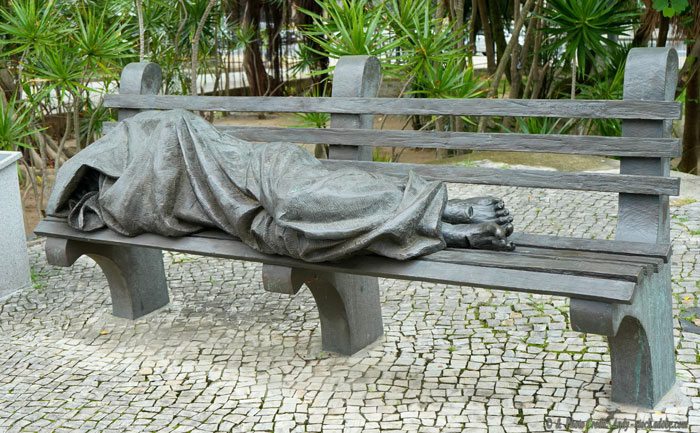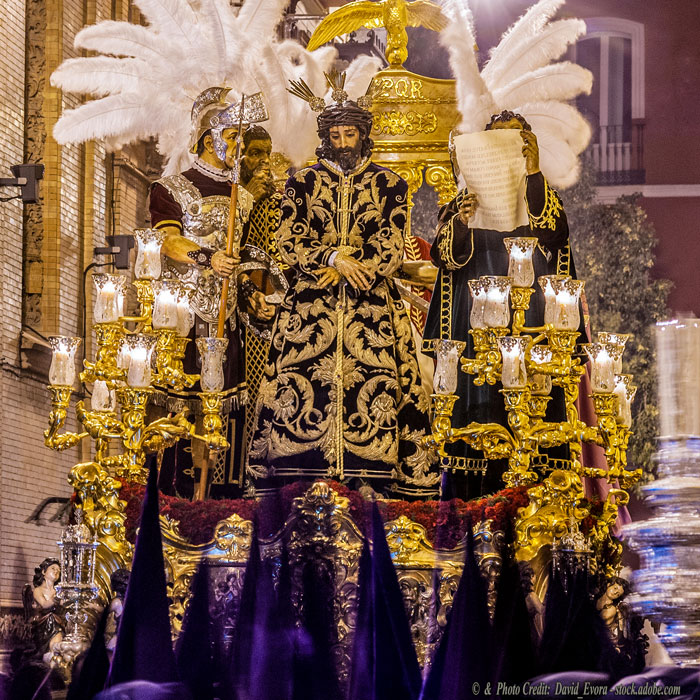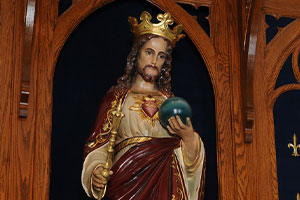During some recent travels, something unexpected caught my eye. While walking past a church in Milwaukee, I noticed what looked like a large slab of bronze lying across a park bench. I walked over to see what it could be.
A small sign identified the work as “Homeless Jesus,” a sculpture meant to depict Our Lord as a vagrant sleeping on a park bench. The artist, Timothy Schmalz, decided to create it after seeing a homeless man sleeping on a park bench in Toronto. The figure’s face and hands were hidden under a blanket, with only the Crucifixion wounds on the feet to hint at the sculpture’s intended identity.
As I stood there reflecting on the statue, a man came up and casually sat on the statue, apparently not knowing what it was supposed to be.

This encounter stuck with me. I could not help but compare this sculpture of Jesus to those figures of Christ seen during the Holy Week processions in Seville, Spain. Both statues portray Our Lord’s suffering. However, only the latter incited compassion, devotion and love in me.
Seville is famous for its grandiose floats paraded through the streets during Holy Week. Life-sized statues of Christ—clothed in scarlet or deep violet velvet and adorned with gold embroidery and precious stones—are carried on massive gilded floats that can weigh up to four tons. These floats are borne by teams of men wearing penitential robes, slowly weaving through the narrow streets amid the sound of drums, trumpets and solemn chants.

Even in His suffering, these statues proclaim Christ’s nobility and kingship. They do not shy away from showing His agony but elevate it. They show that His suffering was not one of defeat but a victorious offering for the redemption of man. Christ is seen as the King of kings, even as He wears a crown of thorns.
Now, compare this portrayal with the “Homeless Jesus” statue. Made of cold, dark bronze, it presents an image devoid of nobility and glory. It does not inspire adoration or devotion but ordinariness and insignificance. It suggests that Our Lord was a tramp. His Divinity did not shine through his appearance, calling men to lift their souls upward. This sculpture is an invitation to do exactly the opposite.
His glory is completely hidden—literally beneath a blanket.
Would the Poor Give Him a Park Bench—or a Throne?
Some claim the statue is meant to portray His humility or provoke social awareness. It is much more of a political statement aimed at highlighting social inequalities than evangelical poverty. I did not sense anything supernatural in this “humble” portrayal.
Humility is not the same as humiliation. Saints throughout history have helped the poor by lifting them up, not by idealizing their plight. Even when presenting Our Lord in the worst moments of His Passion, artists in Seville made sure He maintained His dignity and grandeur. They incite our compassion and admiration.
 Order Today: Return to Order: From a Frenzied Economy to an Organic Christian Society—Where We’ve Been, How We Got Here, and Where We Need to Go
Order Today: Return to Order: From a Frenzied Economy to an Organic Christian Society—Where We’ve Been, How We Got Here, and Where We Need to Go
To drive this point home, I would like to recall a beautiful story from The Glories of Mary, written by Saint Alphonsus Liguori.
It describes a poor shepherdess who regularly visited a humble mountain chapel to pay homage to Our Lady. With her limited means, she would gather flowers and weave them into a crown, placing them lovingly on the Virgin’s head, saying:
“Oh, my Mother, I wish I could place on thy head a crown of gold and gems, but as I am poor, receive this poor crown of flowers from me and accept it as a token of the love I bear thee.”
Her act of devotion was later rewarded with a vision of Our Lady herself coming to crown the girl on her deathbed and escorting her to Paradise.
Why America Must Reject Isolationism and Its Dangers
The shepherdess gave what little she had—and even in her poverty, she sought to honor Our Lady with small manifestations of beauty, not highlighting misery.
This made me wonder: what would this same shepherdess have done for Our Lord if she had the same resources as Timothy Schmalz?
Would she have draped Our Lord in a ragged bronze blanket or given Him silk robes? Would she have given Him a park bench or a noble throne? Would she have wrapped His Head in a ragged blanket or given Him a crown of gold?
Who Gave Permission to Present Our Lord Like This?
It shocked me to learn that over 100 life-sized “Homeless Jesus” statues have been installed around the world since 2013. Many have praised them as “empowering” or “thought-provoking” but never devotional.
Satanic Christ Porn-blasphemy at Walmart — Sign Petition
Such portrayals should not go unchallenged. People need to question the impact of these statues on their souls.
Unfortunately, I don’t believe this is happening because people are too afraid to question the official narrative that tends to see Jesus as an ordinary man and not as our Divine Redeemer and King. Instead of asking why portraying Our Lord in such a state is objectionable, most people accept it blindly.
They do this because confronting the issue forces an uncomfortable conversation. It means reaching conclusions that will offend some and anger others. Worse still, it demands action—an action that goes against human respect and risks social censure. So, we are told to stay silent lest we appear “uncharitable.”
Such sculptures are supposedly made to attract young people like me. However, I find no attraction in this portrayal and feel the need to speak the truth, even if it sends some shockwaves. If we remain silent, we are complicit in this dethroning of Our Lord.
How Panera’s Socialist Bread Ruined Company
Since the world can lift up this bronze image as its version of Christ, then surely we can raise our voices to proclaim: This is not Christ the King!
Let us always remember the glorious statues of Seville and the devotion of the poor shepherd girl—they speak more deeply of Our Lord’s majesty than Timothy Schmalz ever will.
Photo Credit: © Andy – stock.adobe.com (“Homeless Jesus”)
Photo Credit: © David_Evora – stock.adobe.com (Holy Week Procession)
The post Was Our Lord a King or a Tramp? appeared first on Return to Order.
Click this link for the original source of this article.
Author: Remington Huffaker
This content is courtesy of, and owned and copyrighted by, https://www.returntoorder.org and its author. This content is made available by use of the public RSS feed offered by the host site and is used for educational purposes only. If you are the author or represent the host site and would like this content removed now and in the future, please contact USSANews.com using the email address in the Contact page found in the website menu.








